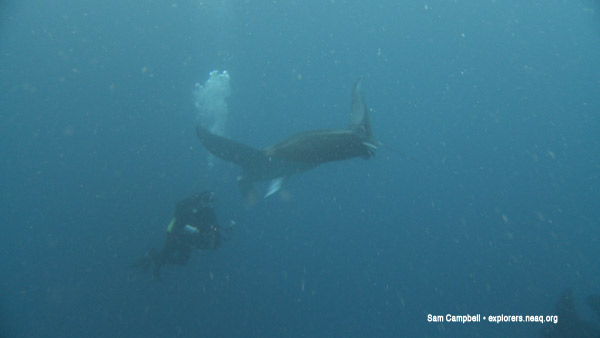With the third day of cold (cold in Fiji defines as below 80 °F), rain beating down, and the wind at this point a constant companion, the bunch of us head out for this late afternoon dive are already shivering and maybe even a bit weary.
The dive sites are the well known Jim's Alley (named after a pioneering underwater photographer, Jim Church) and Anthias Pinnacle (named for the abundant clouds of small, colorful plankton-eating relatives of groupers). The sites are situated such that two skiffs of divers are spread out, but still fairly close, which enables the skiff skippers to communicate almost by shouting, allowing the radios to remain in their covered metal holsters during the driving rain. These dive locations are typically known as macro lens-friendly (small critters) shoots. Today's lens choice was exactly that for all of our photographers because of the poor conditions for wide angle (whole landscape) shots. Why, in detail: The lagoon's tide was running out, laden with plankton and spooge (sea snot, fish poop, and tons of weenie stuff that requires a microscope to ID it), and it all contributes to a crummy 30' of visibility; dramatically different than the 150' we experienced at Nigali Passage (as seen in this post) during the morning.
Just as we arrive Sr. Dive Master Mo slips over the side to check on the ferocity of the current, and immediately returns shouting "Manta! Manta!" Unfortunately, he adds that it's swimming away fast. Oh, well. Figures that an iconic, dynamic, squared-away animal such as Manta birostris would be headed for parts seemingly more upbeat/attractive than where we were about to spend the next hour.
Although the photo equipment used during the dive was all set for macro shooting, these stills from video footage by Sam Campbell show the how close divers came to the manta rays (Stills: Sam Campbell)
The skiff drivers give us the command to roll into the water, and the 12 of us are soon dropping down to 65' to begin our hour. Faces down, we make our rounds slowly looking for the little things that a quick scanning eye often misses. Mo points out small clear shrimp, some nudibranchs, and other bits, but I soon break off to look (unsuccessfully) for an odd-looking arrowhead soapfish Belanoperca chabanaudi that was found here on the '09 expedition. [Note: check out the post about this area from the 2009 expedition here.]
Looking down the mouth of one impressive filter feeder (Photos: Mark Rosenstein)
Certainly all of our grandmothers generally said the same thing regarding being a sour puss. And in that vane, things were about to change in a big hurry. Apparently the entire time most of us had our faces buried in the reef looking for weenie sized things, 50' over our heads at least half a dozen large (6' +) mantas were racing back and forth between Jim's and Anthias sucking in all that spoogey, crummy, low vis water we were all silently or quite loudly complaining about. And pretty much about the same time, all of us with barely any air left in our tanks realize 'there be mantas up thar!' A mad scramble ensues to get off the bottom into the water column and point cameras at critters really too big for the mismatched lenses being aimed at them.
In our exuberance we exhaust any air in our tanks and have to pass off our scuba kit to the skiff drivers. Now confined to the surface by a snorkel, the wind driven waves crash over our heads and swamp those snorkels. Who cares about all that choking and sea water being swallowed?! No one.
Everyone is laughing, whooping, cheering, and making giddy squeaking sounds generally heard from preschoolers, as four, then five, then six large mantas do loop after loop, barrel rolls, and race to the surface to slap it with their huge pectoral fins. Newfound energy is in abundant supply as we NAI’A divers kick hard down hard away from the surface to be right in amongst the impressively choreographed, gracefully swooping mantas. Huge bodies come within inches of one another as they systematically filter feed on the plankton chowder doubling as seawater. Ineffective cameras flash. Pictures are shot despite everyone knowing that it is likely for naught; the act likely being a reflex reaction by now. As the minutes pass, we shout to one another on the surface about the lack of proof we'll have when the retelling of this story starts.
Stormy seas around Gau (Photo: Keith Ellenbogen)
Resident sketch artist, Stacy Jupiter, displaying impressions of the barrel rolling mantas
(Photo: Keith Ellenbogen)
The local Gau villagers have shared with the NAI'A over the years that on rainy days, they have witnessed the mantas in their large lagoon frolicking. So, remember, your grandmother knew what she was talking about.
Note:
Although it is not illegal to fish for manta (a totem for many tribes) in Fiji, they are likely targeted by fishermen for overseas markets.
-Bailey






No comments:
Post a Comment